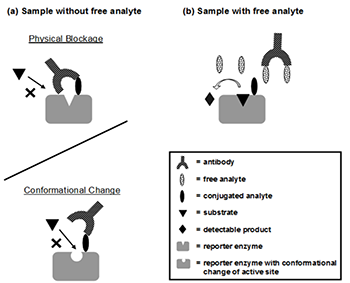

Project Overview
A need remains for a convenient, low-cost method for detection of estradiol. We recently demonstrated a homogeneous immunoassay that enables estradiol detection in a few minutes after a simple mixing step, in contrast to time-consuming ELISA methods that typically require multiple binding and washing steps. Our immunoassay is distinguished by its reliance on antibody-induced inhibition of a reporter enzyme-analyte conjugate. When antibody binds to the conjugate, a physical blockage and/or a conformational change of the enzyme active site occurs, reducing intrinsic catalytic activity. When introduced with antibody, free analyte competes for antibody binding, thereby partially preventing repression and resulting in a signal proportional to analyte concentration. We have extended this technique to the detection of peptides and proteins. Work to create an electrochemical signal transduction approach for the immunoassay is underway.
Students
Publications
Chiu, May L., Ytterberg, A. Jimmy, Ogorzalek Loo, Rachel R., Loo, Joseph A., Monbouquette, Harold G., Characterization of Morphine-Glucose-6-phosphate Dehydrogenase Conjugates by Mass Spectrometry, Bioconj. Chem., 22(8), 1595-1604 (2011)
Chiu, May L., Tseng, Tina T.-C., Monbouquette, Harold G., A convenient homogeneous enzyme immunoassay for estradiol detection, Biotechnol. Appl. Biochem., 58(1), 75-82 (2011)
Chiu, May L.; Lai, Denton; Monbouquette, Harold G. An Influenza Hemagglutinin A Peptide Assay Based On The Enzyme-Multiplied Immunoassay Technique, J. Immunoassay Immunochem., 32(1), 1-17 (2011)
F.H. Ko and H.G. Monbouquette, Photometric and Electrochemical Enzyme-Multiplied Assay Techniques Using β-Galactosidase as Reporter Enzyme, Biotechnol. Progr., 22, 860-865 (2006)
Copyright © Monbouquette Laboratory.
Last updated: 03/10/2015